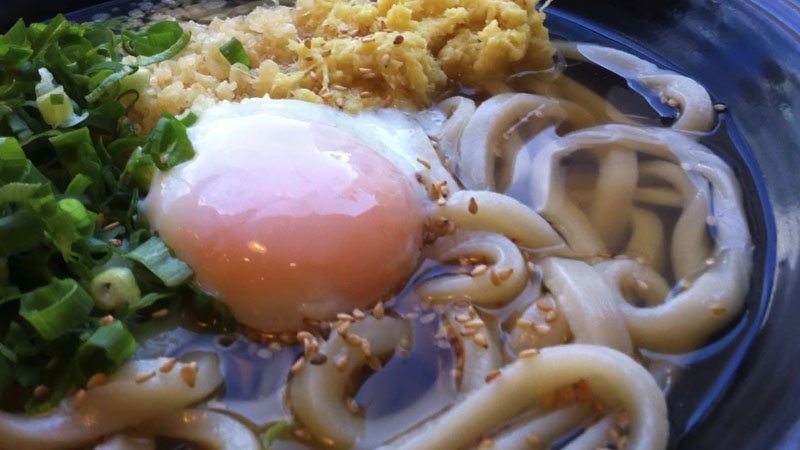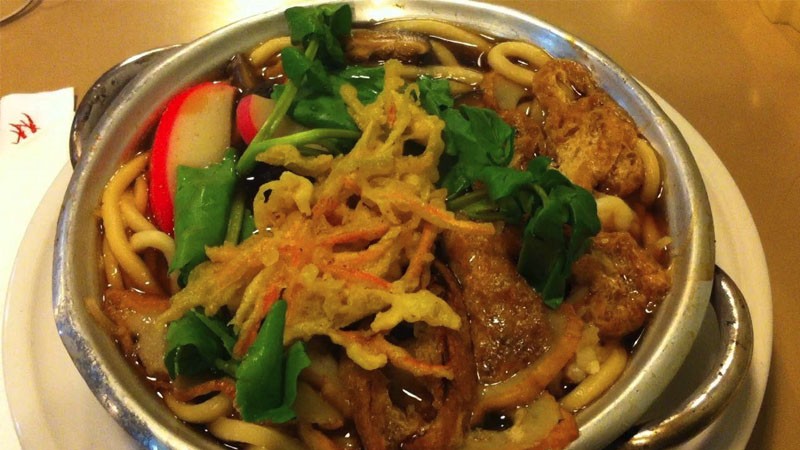Udon (うどん or 饂飩) is a thick Japanese noodle made from wheat flour. This noodle is usually thicker and white than soba, and has a broth made from dashi, mirin and soy sauce. There are thousands of different types of udon, hot and even cold dishes. The famous udon it can be found across Japan in thousands of specialty restaurants, casual, family and even izakaya restaurants.
You can find a udon dish starting at 500 yen, and they are usually varied, each region of Japan has its own mix of ingredients. The most common ingredients that complete the udon are: negi (chives), tempura, eggs, meat and other vegetables.
The origin of the udon in Japan has been credited to the Buddhist priest Kobo Daishi or Kukai. Kukai traveled to China around the beginning of the 9th century to study Buddhism. When he returned, he brought the knowledge of udon soup to his homeland in the vicinity of the Sanuki region of Japan.
The way the pasta is prepared has a total influence on the taste of this delicious pasta. The selection of ingredients reflects the seasonality of the seasons and they are balanced with other ingredients. Many ingredients are added without much cooking, some are deep fried, cut into very thin slices. All these details influence the preparation of the pasta.
Índice de Conteúdo
How to eat udon
The correct way to eat udon will depend on how it is served, each dish can have a different way. When udon is served with a separate dip sauce, you should dip the pasta in the sauce before eating.
When udon is served inside the sauce, you should eat the noodles using the chopsticks, and there is no problem sucking and making noise, this is considered a sign that it tastes good. Most of the time, you should drink the broth directly from the bowl where the pasta is. In some places you can get a spoon, but forget about it.
Types of Udon
Zaru - Cold noodles served on a bamboo mat. It is accompanied by a dipping sauce and are dipped in the sauce before eating.
Kake - Dish served in a hot broth that covers the pasta. It has no cover and is usually decorated with green onions.
Kamaage - Pasta served in hot water, accompanied by a variety of spices and a dipping sauce.
Chikara - It literally means strength or power. It is covered with toasted mochi dumplings. A very strong dish.
Kare - Made from Japanese Curry. Sometimes with meat and vegetables.
Kitsune - It literally means Fox. It is covered with abura age (fried tofu) and is quite popular in the Kansai region, mainly Osaka.
There are several other varieties, there are regional, seasonal udon, original restaurant recipes and mixes, creating an infinite variety of udon, not to mention the infinite varieties of soba.
Udon Facts
Finally, let's leave the video of our friend Santana Fonseca from the channel Japan Guide and a recipe for you to make your udon. In this video you will know more curiosities about this delicious dish.
The article is still halfway through, but we recommend also reading:
Udon recipe
Ingredients:
- 1 packet of udon noodles (Japanese noodles)
- 1 tablespoon of oil
- 1 clove of garlic
- 1 package of hondashi
- 1 spoon of ajinomoto coffee
- 1 chicken breast or other meat cut into cubes
- Shoyu to taste (about half a cup of tea)
- 1 chopped onion
- 1 beaten egg
- 1 cup chopped chives
- Another ingredient to complement the recipe.
- The measurements of the ingredients can be chosen by your preference;
Preparation mode
- Boil a pan with plenty of water, when it starts to boil, put the pasta and cook;
- Drain the pasta and set aside, meanwhile, place a pan of oil and fry the garlic;
- Add the meat and saute until it browns and add 2 liters of water;
- Put the hondashi and ajinomoto and add the soy sauce and seasoning gradually;
- Place the onion and egg and stir well, let it boil for another 5 minutes and turn off the heat;
- Add the chopped chives and add its complementary ingredients to taste;
- Place the noodles in the bowl and place the broth on top as you wish;
There are several different ways to prepare an udon. I hope you enjoyed this article.








